Power Play Chapter Notes | Chapter Notes For Class 8 PDF Download
| Table of contents |

|
| Experiencing the Power Play ... |

|
| Exponential Notation and Operations |

|
| The Stones that Shine ... |

|
| The Other Side of Powers |

|
| Powers of 10 |

|
| Did You Ever Wonder? |

|
| A Pinch of History |

|
Experiencing the Power Play ...
An Impossible Venture!
How many times can you fold it over and over?
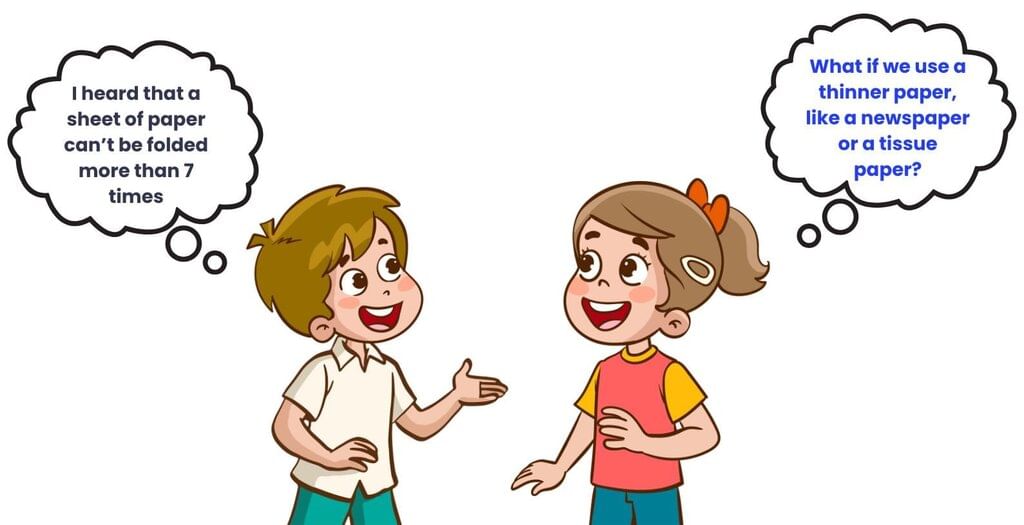 Estu and Roxie
Estu and Roxie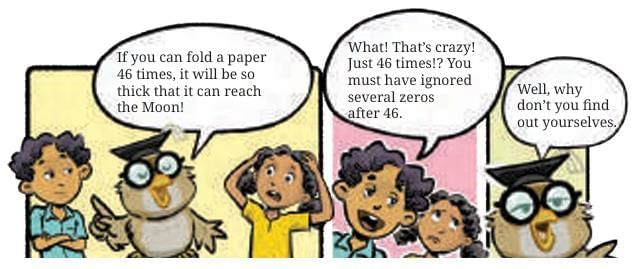
Let's find out how thick a paper would be after 46 folds, assuming its starting thickness is 0.001 cm.
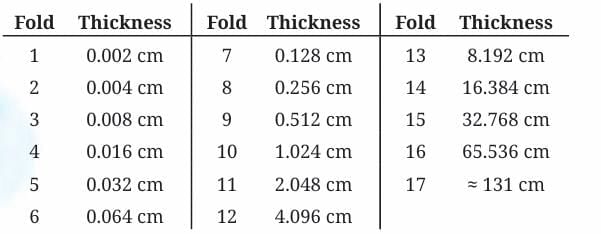
What happens when you fold a paper many times?
Every time you fold a paper, its thickness doubles.
That means:
After 1 fold → thickness becomes 2 times
After 2 folds → thickness becomes 4 times (2 × 2)
After 3 folds → thickness becomes 8 times (2 × 2 × 2)

You can see that each time, the thickness doubles.
What happens after 10 folds?
The thickness becomes 1024 times more than before.
This is because:
So, every 10 folds increase the thickness by 1024 times (That is 2 multiplied by itself 10 times), no matter where you start from.
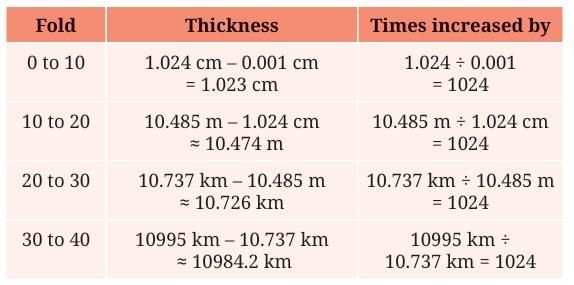
Exponential Notation and Operations
Let's understand what is happening when paper is folded!
The paper’s thickness doubles every time it is folded. The starting thickness of a paper is 0.001 cm.
Example:
Initial thickness = 0.001 cm
After folding once → 0.001 × 2 = 0.002 cm
After folding twice → 0.001 × 2 × 2 = 0.004 cm, or 0.001 × 2² = 0.004 cm
After folding thrice → 0.001 × 2 × 2 × 2 = 0.008 cm, or 0.001 × 2³ = 0.008 cm
After folding four times → 0.001 × 2⁴ = 0.016 cm
So, every time you fold the paper, you multiply the thickness by 2.
The General pattern becomes,
The thickness after folding the paper several times can be written using powers (exponents).
After folding it 7 times → 0.001 × 2 × 2 × 2 × 2 × 2 × 2 × 2
= 0.001 × 2⁷
= 0.128 cmAfter folding it n times → 0.001 × 2n
This pattern shows how the thickness grows very fast using powers of 2.
What is Exponential Notation?
Exponential notation is a shorthand way of writing repeated multiplication of the same number.
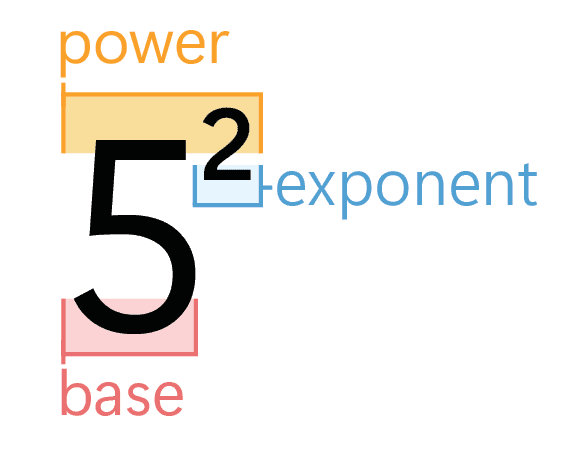
Let’s explore how it works!
n × n = n²
Read as “n squared” or “n raised to the power 2”n × n × n = n³
Read as “n cubed” or “n raised to the power 3”n × n × n × n = n⁴
Read as “n raised to the power 4”n × n × n × n × n × n × n = n⁷
Read as “n raised to the power 7”
In general:
nᵃ means you are multiplying n by itself a times.
Example:
- 5⁴ = 5 × 5 × 5 × 5 = 625
- So, 5⁴ is the exponential form of 625.
- Here, 4 is the exponent or power, and 5 is the base.
It is read as:
“5 raised to the power 4”
“5 to the power 4”
“5 power 4”
“4th power of 5”
Another Example:
2 × 2 × 2 × 2 × 2 × 2 × 2 × 2 × 2 × 2 = 210 = 1024
Remember 210 ? It shows that after folding a paper 10 times, it becomes 1024 times thicker!
Exploring Positive and Negative Bases
Example 1: Positive Base
4 × 4 × 4 = 4³ = 64
Here, the base is 4, which is a positive number. We are multiplying it by itself 3 times.
Since multiplying positive numbers always gives a positive result, the final answer is 64.
This is read as:
“4 raised to the power 3”
“4 cubed”
Example 2: Negative Base
(–4) × (–4) × (–4) = (–4)³ = –64
Here, the base is –4, which is a negative number. We are multiplying it by itself 3 times.
Let’s break it down:
Step 1: First multiplication:
(–4) × (–4) = 16
→ Multiplying two negative numbers gives a positive result.
Step 2: Second multiplication:
16 × (–4) = –64
→ Multiplying a positive result by a negative number gives a negative result.
So, the final answer is –64.
Quick Tip:
1. A positive base always gives a positive result no matter how many times you multiply it.
2. A negative base can give either a positive or negative result depending on the exponent:
If the exponent is even (like 2, 4, 6…), the result is positive.
If the exponent is odd (like 3, 5, 7…), the result is negative.
Using Letters (Algebra) in Exponential Form
When letters are multiplied, we can also use exponents:
a × a × a × b × b
= a³ × b²
This is read as "a cubed times b squared"a × a × b × b × b × b
= a² × b⁴
This is read as "a squared times b raised to the power 4"
So, each letter is multiplied by itself the number of times shown in the exponent.
Lets Explore!
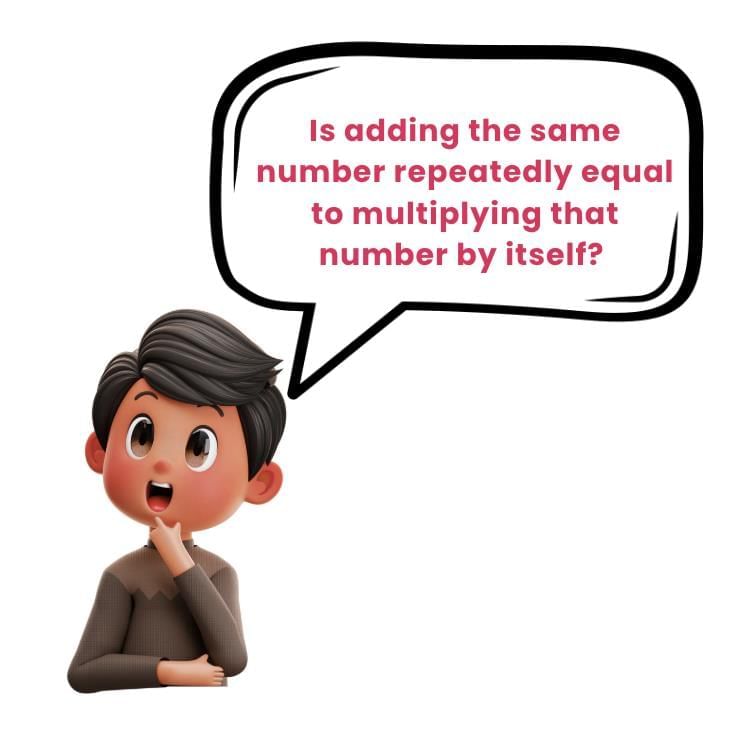
Adding powers is not the same as multiplying numbers:
Example:
4 + 4 + 4 = 3 × 4 = 12
Whereas,
4 × 4 × 4 = 4³ = 64
Expressing Large Numbers as Exponents
We can write big numbers in a simpler way using their prime factors and exponents! This helps us easily understand how numbers are built.
Example: 3600
Step 1: Prime Factorisation
We break 3600 into its prime factors: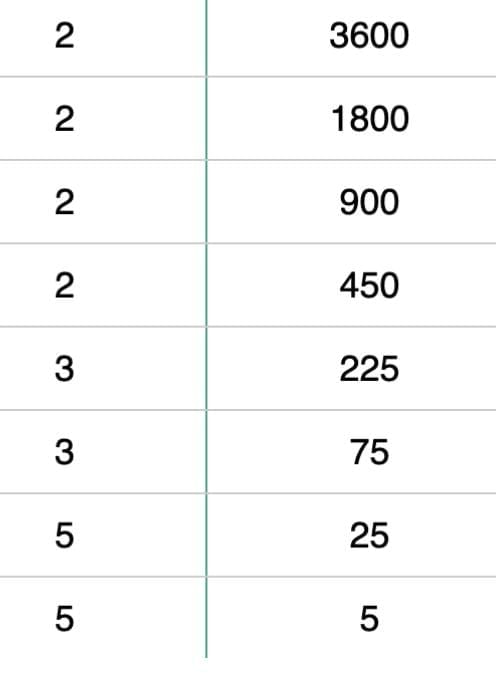
3600 = 2 × 2 × 2 × 2 × 3 × 3 × 5 × 5
So we have:
- Four 2s
- Two 3s
- Two 5s
Step 2: Writing in Exponential Form
Now we group the same prime numbers and use exponents to show how many times each is used:
2 × 2 × 2 × 2 = 2⁴
3 × 3 = 3²
5 × 5 = 5²
So, in exponential form:
3600 = 2⁴ × 3² × 5²
Try yourself!
Q: Express the number 32400 as a product of its prime factors and represent the prime factors in their exponential form.
 View Answer
View Answer 
Step 1: Prime Factorisation
We break 32400 into its prime factors:
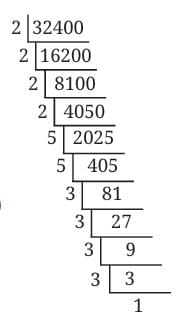
32400 = 2 × 2 × 2 × 2 × 3 × 3 × 3 × 3 × 5 × 5
So we have:
- Four 2s
- Four 3s
- Two 5s
Step 2: Writing in Exponential Form
Now we group the same prime numbers and use exponents to show how many times each is used:
- 2 × 2 × 2 × 2 = 2⁴
- 3 × 3 × 3 × 3 = 3⁴
- 5 × 5 = 5²
So, in exponential form:
32400 = 2⁴ × 3⁴ × 5²
The Stones that Shine ...
Three daughters with curious eyes,
- Each got three baskets—a kingly prize.
- Each basket had three silver keys,
- Each opens three big rooms with ease.
- Each room had tables—one, two, three,
With three bright necklaces on each, you see.
Each necklace had three diamonds so fine…
Can you count these stones that shine?
Hint: Find out the number of baskets and rooms
Let’s Explore the Types of Multiplication Patterns

The king has 3 daughters.
Each daughter gets 3 baskets
→ so total baskets = 3 × 3 = 9.Each basket has 3 keys, each key opens 3 rooms.
So the story is building layers of 3’s.
This is a multiplication tree — every step multiplies by 3.
Step 1: Daughters and baskets
3 daughters
Each daughter has 3 baskets
→ 3 × 3 = 9 baskets
Step 2: Keys and rooms
Each basket has 3 keys
Each key opens 3 rooms
→ 9 × 3 × 3 = 81 rooms
Step 3: Tables in rooms
Each room has 3 tables
→ 81 × 3 = 243 tables
Step 4: Necklaces on tables
Each table has 3 necklaces
→ 243 × 3 = 729 necklaces
Step 5: Diamonds on necklaces
Each necklace has 3 diamonds
→ 729 × 3 = 2187 diamonds
Hence, total diamonds = 3 × 3 × 3 × 3 × 3 × 3 × 3 = 3⁷ = 2187
When we multiply the same base repeatedly, we use exponents.
Here, the base is 3, repeated 7 times, so it becomes 3 to the power 7 (3⁷).
Rules of Exponents
1. Repeated Multiplication
Multiplication of the same number again and again can be written in a shorter form.
Example:
- 3 × 3 = 9
- 3 × 3 × 3 = 27
- 3 × 3 × 3 × 3 = 81
This can be written as powers of 3:
3² = 9
3³ = 27
3⁴ = 81
If the base is the same, just add the powers:
p⁴ × p⁶ = p¹⁰
because (p × p × p × p) × (p × p × p × p × p × p) = p¹⁰
From the story,
Repeated multiplication can be written as powers (exponents).
Exponents help in solving big calculations quickly.
When bases are the same, we add the powers.
This method shows how numbers grow very fast with repeated multiplication.
Example from the story: Total diamonds = 2187 (3⁷).
Magical Pond
In the middle of a beautiful, magical pond lies a bright pink lotus. The number of lotuses doubles every day in this pond. After 30 days, the pond is completely covered with lotuses.

Let's Explore!

Okay, here’s the solution without latex:
The number of lotuses doubles every day.
On the 30th day, the pond is completely full.
That means on the 29th day, the pond had half as many lotuses as on the 30th day.
So, the pond was half full on the 29th day

Let’s assume we start with 1 lotus on day 1.
The number of lotuses doubles each day, so:
- On day 1: 1 lotus
- On day 2: 1 × 2 = 2 lotuses
- On day 3: 2 × 2 = 4 lotuses
- On day 4: 4 × 2 = 8 lotuses
- And so on.
This pattern shows the number of lotuses on day “n” is 2(n-1).
For day 30 (fully covered):
- Number of lotuses = 2(30-1) = 229.
For day 29 (half covered):
- Number of lotuses = 2(29-1) = 228.
- (i) Fully covered (day 30): 229 lotuses
- (ii) Half covered (day 29): 228 lotuses
The Tripling Pond
There is another pond in which the number of lotuses triples every day. When both ponds had no flowers, Damayanti placed a lotus in the doubling pond. After 4 days, she took all the lotuses from there and put them in the tripling pond.
Let's Explore!
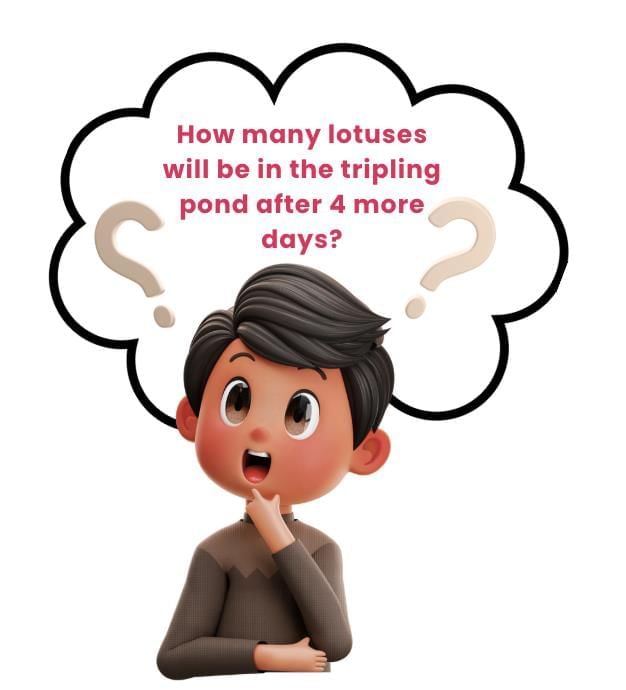
Process:
Start with 1 lotus in doubling pond.
After 4 days:
1 × 2 × 2 × 2 × 2 = 2⁴Shift to tripling pond.
After next 4 days:
2⁴ × 3 × 3 × 3 × 3 = 2⁴ × 3⁴
Q: What if Damayanti had changed the order in which she placed the flowers in the lakes? How many lotuses would be there?
Doubling Pond: The number of lotuses doubles every day.
Tripling Pond: The number of lotuses triples every day.
Damayanti placed 1 lotus in the Doubling Pond.
After 4 days in the doubling pond: 16 lotuses.

Then she moved them to the Tripling Pond for another 4 days:

So, 16 × 81 = 1296 lotuses.
After 4 days in the tripling pond:

Then moved to the doubling pond for 4 days:

Notice:
Conclusion: So the order does not matter, as long as exponents are the same.
Rule from Observation
1. Multiplication law: 
Why?
mᵃ means multiplying m × m × m × m..... a times.
nᵃ means multiplying n × n × n × n ..... a times.
Together they form (m × n) multiplied a times.
Example:
2⁴ × 3⁴ = (2 × 3)⁴ = 6⁴
2. Division Law: 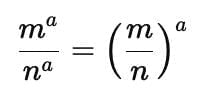
Why?
mᵃ = m × m × m × … (a times)
nᵃ = n × n × n × … (a times)
Divide term by term → (m ÷ n) × (m ÷ n) × … (a times)
So result = (m ÷ n)ᵃ
How Many Combinations
Estu has 4 dresses and 3 caps. How many different ways can Estu combine the dresses and caps?
To find the total number of combinations:
For each cap, Estu can wear 4 different dresses.
So for 3 caps:
4 + 4 + 4 = 12 combinations
Or, 4 × 3 = 12 combinations
Similarly, for each dress, he can wear 3 different caps.
So for 4 dresses:
3 + 3 + 3 + 3 = 12 combinations
Or, 3 × 4 = 12 combinations

Estu and Roxie came across a safe containing old stamps and coins that their great-grandfather had collected. It was secured with a 5-digit password. Since nobody knew the password, they had no option except to try every password until it opened. They were unlucky and the lock only opened with the last password, after they had tried all possible combinations. How many passwords did they end up checking?
To make it easier, first try a simpler version:
(a) 2-digit Lock:
Each digit has 10 options: 0 to 9
So total combinations = 10 × 10 = 100 passwords
These are: 00, 01, 02, ..., 99
(b) 3-digit Lock:
Now, add one more digit to each 2-digit password
Total = 100 (previous combinations) × 10 = 1,000 passwords
From 000 to 999
(c) 5-digit Lock:
Each digit has 10 options
So total = 10 × 10 × 10 × 10 × 10 = 100,000 passwords
From 00000 to 99999
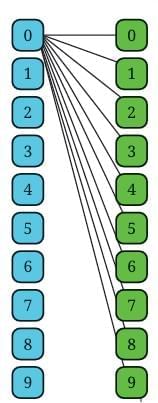
Lock Combinations
The Other Side of Powers
Imagine a line that is 16 units long.
We know:
16 = 2 × 2 × 2 × 2 = 2⁴
Now, if we erase (remove) half of the line:
We divide 16 by 2 →
16 ÷ 2 = 8
8 = 2 × 2 × 2 = 2³
Now, erase half again:
8 ÷ 2 = 4
4 = 2 × 2 = 2²
Again, erase half a third time:
4 ÷ 2 = 2
2 = 2¹
So, we started from 2⁴ and after dividing by 2 three times, we reached 2¹.
We can write this as:
2⁴ ÷ 2³ = 2¹
Or, 2⁴ ÷ 2³ = 2(4-3) = 2¹
General Rule of Dividing Powers
If you divide two powers with the same base, you subtract the exponents.
That means:
nᵃ ÷ nᵇ = n⁽ᵃ ⁻ ᵇ⁾,
where n is not zero, and a > b.
Try This
What is:
2100 ÷ 225?
Use the rule:
2¹⁰⁰ ÷ 2²⁵ = 2⁽¹⁰⁰ ⁻ ²⁵⁾ = 2⁷⁵
Why Can’t n Be 0?
We have a rule:
nᵃ ÷ nᵇ = nᵃ⁻ᵇ, where n ≠ 0
Let’s see why n cannot be 0:
Example:
Take:
2⁴ ÷ 2⁴ = 2⁴⁻⁴ = 2⁰
Now,
2⁴ = 16
So, 2⁴ ÷ 2⁴ = 16 ÷ 16 = 1
Therefore, 2⁰ = 1
In fact for any letter number a
20 = 2a – a = 2a ÷ 2a = 1.
In general,
xa ÷ xa = xa – a = x0, and so
1 = x0 ,
where x ≠ 0 and a is a counting number.
So, any number when raised to the power 0 is equals to 1.
This rule works for any number except 0.
Let’s say we halve a line of length 2⁴ = 16 units again and again:
Halve it 5 times:
2⁴ ÷ 2⁵ = 
But by using the above general form we can write,
2⁴ ÷ 2⁵ = 2⁴⁻⁵ = 2⁻¹
That means: 2⁻¹ = 1 ÷ 2 =

Halve it 10 times:
In general form we can write: 2⁴ ÷ 2¹⁰ = 2⁴⁻¹⁰ = 2⁻⁶
In normal form we can write: 2⁴ ÷ 2¹⁰ =

So, we learn:
n-a = 1 ÷ nᵃ, and
nᵃ = 1 ÷ n⁻ᵃ , where n is not a zero
Summary of General forms:

Power Lines
Power line is a line having all the powers of a number on it, this helps us in making difficult power calculations, very easy
Let us arrange the powers of 4 along a line.
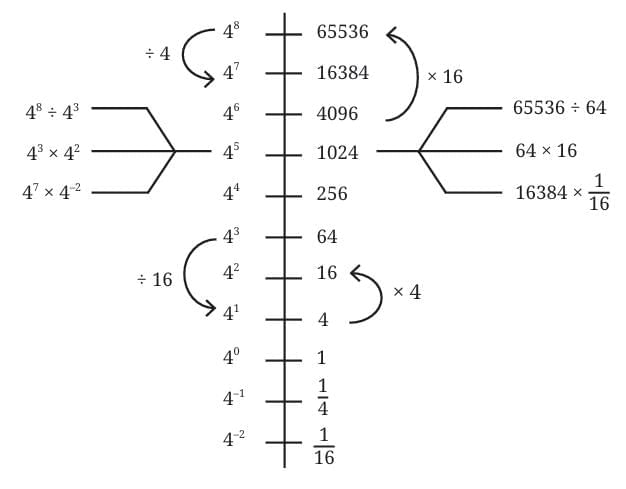
Power Line of 4
Q. Can we say that 16384 (47) is 16 (42) times larger than 1,024 (45)?
Yes, since 47 ÷ 45 = 4(7-5) = 42.
Q. How many times larger than 4–2 is 42
42 ÷ 4-2 = 4 (2-(-2)) = 4(2+2) = 44
So, 42 is 44 larger than 4–2
Powers of 10
What are Powers of 10?
"Powers of 10" means writing numbers using exponents of 10. This is a shorter and easier way to show how many times 10 is multiplied.
For example:
10 = 10¹ (10 is multiplied once)
100 = 10² (10 × 10)
1000 = 10³ (10 × 10 × 10)
Using Powers of 10 in Numbers
Let’s take a number and write it in expanded form and then in powers of 10:
Example: 47561
Expanded form:
47561 = (4 × 10000) + (7 × 1000) + (5 × 100) + (6 × 10) + (1)
Now, write these place values using powers of 10:
10000 = 10⁴
1000 = 10³
100 = 10²
10 = 10¹
1 = 10⁰
So,
Using powers of 10:
47561 = (4 × 10⁴) + (7 × 10³) + (5 × 10²) + (6 × 10¹) + (1 × 10⁰)
What about Decimal Numbers?
Let’s look at 561.903
How can we write 561.903?
Expanded form (separating whole and decimal parts):
= (5 × 100) + (6 × 10) + (1 × 1) + (9 × 1/10) + (0 × 1/100) + (3 × 1/1000)
Now, write them using powers of 10:
100 = 10²
10 = 10¹
1 = 10⁰
1/10 = 10⁻¹
1/100 = 10⁻²
1/1000 = 10⁻³
So,
Using powers of 10:
561.903 = (5 × 10²) + (6 × 10¹) + (1 × 10⁰) + (9 × 10⁻¹) + (0 × 10⁻²) + (3 × 10⁻³)
Scientific Notation
Why Do We Need Scientific Notation?
When we deal with very large numbers, it becomes hard to:
Count the number of zeroes correctly.
Place commas at the right positions.
Read or write the number without making mistakes.
Example:
It is easy to confuse ₹5,000 with ₹50,000 just because of one missing zero.
To avoid such confusion, we use a way of writing numbers called Scientific Notation (also known as Standard Form).
What is Scientific Notation?
Scientific Notation is a method to write very large or very small numbers using powers of 10.
Format:
A number in scientific notation is written as:
x × 10y,
where:
x is a number between 1 and 10 (called the coefficient),
y is an exponent (any whole number), and
10y shows how many times 10 is multiplied.
Example of Breaking a Number into Scientific Notation
Let’s take the number 5900.
We can write it in many ways using powers of 10:
5900 = 590 × 10
= 59 × 10²
= 5.9 × 10³ → This is the correct scientific notation
(Because 5.9 is between 1 and 10)
Another example:
80,00,000 = 8 × 10⁶
Why Is Scientific Notation Useful?
Let’s look at some big facts:

This helps us read and write large numbers easily and quickly.
Importance of the Exponent (Power of 10)
In the scientific form x × 10y, the exponent y is very important:
It tells us how big the number is.
Changing x changes the number a little.
Changing y changes the number a lot.
Example:
2 × 10⁷ = 2 crore
3 × 10⁷ = 3 crore → Only 50% more
But 2 × 10⁸ = 20 crore → 10 times more
Accuracy and Approximation
When we say Kohima has a population of 1,42,395, it seems like we are sure about the number right down to the last person.
But often, when we use big numbers, we are not always interested in the exact value. We just want to know how big the number is.
If we are only sure that the population is about 1,42,000, we can write it as:
1.42 × 10⁵If we are only sure it's about 1,40,000, we can write: 1.4 × 10⁵
In scientific notation, the number of digits in the beginning (called the coefficient) shows how accurately we know the value.

When we talk about very old things, like a dinosaur’s skeleton, we say:
"It is 70 million years old."
We don’t usually add the exact number of years (like 70 million and 15 years), because it doesn’t matter much.
These are rounded-off numbers, and that is good enough for most purposes.
We often use scientific notation to write very large distances:
Distance from Sun to Saturn:
14,33,50,00,00,000 m
= 1.4335 × 10¹² m
Distance from Saturn to Uranus:
14,39,00,00,00,000 m
= 1.439 × 10¹² m
Distance from Sun to Earth:
1,49,60,00,00,000 m
= 1.496 × 10¹¹ m
These scientific forms make large numbers easier to read and compare.
Did You Ever Wonder?
Last year, you learned some fun thinking activities (thought experiments) in your Large Numbers chapter. Let’s continue that with a new situation.
The Situation
A man named Nanjundappa wants to donate:
- Jaggery equal to the weight of Roxie
- Wheat equal to the weight of Estu
He is trying to find out how much money this donation would cost him.

How Do We Calculate the Cost?
We use these formulas:
- Cost of Jaggery = Roxie’s weight × Cost of 1 kg of jaggery
- Cost of Wheat = Estu’s weight × Cost of 1 kg of wheat
Make Assumptions (Use Reasonable Values)
If we don’t know the exact weights or prices, we can make reasonable guesses.
Let’s assume:
- Roxie is 13 years old and weighs 45 kg
- Cost of 1 kg of jaggery is ₹70
Then,
Jaggery cost = 45 × 70 = ₹3150
Now assume:
- Estu is 11 years old and weighs 50 kg
- Cost of 1 kg of wheat is ₹50
Then,
Wheat cost = 50 × 50 = ₹2500
A Cultural Tradition
This kind of donation is called Tulābhāra or Tulābhāram.
It means donating something (like jaggery, fruits, coins, etc.) equal to a person’s weight.
It is:
A symbol of devotion or surrender (bhakti)
A way of showing gratitude
A support to the community
Roxie now wonders:
If I donate 1-rupee coins equal to my weight, how many coins will I need?
To find this, you can follow these steps:
Problem Solving Steps
Step 1: Guess
Make a quick guess without doing any maths.
Step 2: Estimate & Calculate
(i) Understand the relationship:
Total weight of coins = Roxie’s weight
(ii) Make assumptions:
For example, assume 1 coin weighs 5 grams
(iii) Do the math:
Convert Roxie’s weight to grams (1 kg = 1000 grams → 45 kg = 45000 grams)
Now divide by the weight of 1 coin:
45000 ÷ 5 = 9000 coins
This is how you solve such interesting real-life math problems using logic, estimation, and some simple calculations.
Linear Growth vs. Exponential Growth

Roxie is reading a science-fiction story where someone builds a ladder to reach the Moon.
She wonders,
“If such a ladder were real, how many steps would it need?”
Make a Guess
Before calculating, try to guess:
Would the number of steps be in thousands, lakhs, crores, or even more?
Let’s Do the Math
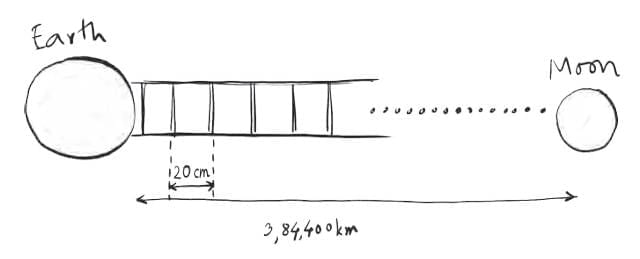
Step 1: Distance to the Moon
The Moon is about 3,84,400 kilometers away from Earth.
Step 2: Step Size
Let’s assume each step of the ladder is 20 cm apart.
(Remember: 100 cm = 1 metre, 1000 metres = 1 km)
Step 3: Convert Units
Convert 3,84,400 km to centimeters:
1 km = 1,00,000 cm
So,
3,84,400 km = 3,84,400 × 1,00,000 = 38,44,00,00,000 cm
Now divide by 20 cm (each step):
Number of steps = 38,44,00,00,000 ÷ 20 = 1,92,20,00,000 steps
(which is 192 crore and 20 lakh steps, or 1.922 billion steps)
What Is Linear Growth?
This ladder increases in a fixed way — each step is 20 cm.
So you add 20 cm every time:
20 + 20 + 20 + 20 + ... (1,92,20,00,000 times)
This kind of growth is called Linear Growth — where the value increases by the same amount each time.
What Is Exponential Growth?
Now imagine folding a piece of paper:
First fold = 2 layers
Second fold = 4 layers
Third fold = 8 layers
Fourth fold = 16 layers
and so on...
This growth multiplies each time, not adds.
This is Exponential Growth — the value doubles (or multiplies) every time.
To cover the distance between the Earth and the Moon, it takes
1,92,20,00,000 steps with linear growth whereas it takes just 46 folds of
a piece of paper.

This shows how fast exponential growth can become large compared to linear growth.
Getting a Sense for Large Numbers
You have already learned:
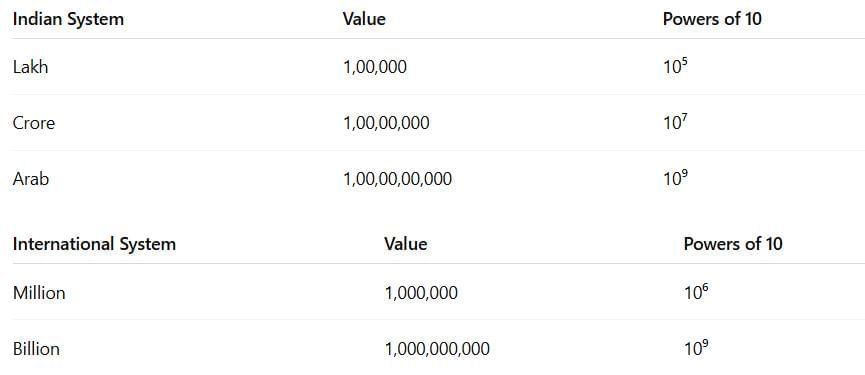
Number System
We use these systems to count very large quantities
You might know the size of the world’s human population. Have you ever wondered how many ants there might be in the world or how long ago humans emerged? In this section, we shall explore numbers significantly larger than arabs and billions. We shall use powers of 10 to represent and compare these numbers in each case.
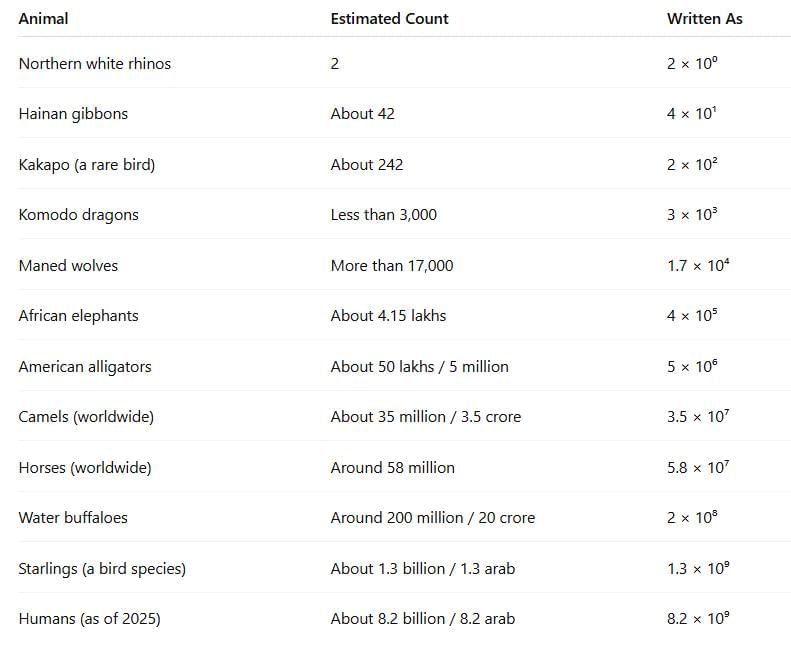
- Large numbers are easier to handle using powers of 10.
- Animal and human populations are often expressed this way to keep things simple and clear.
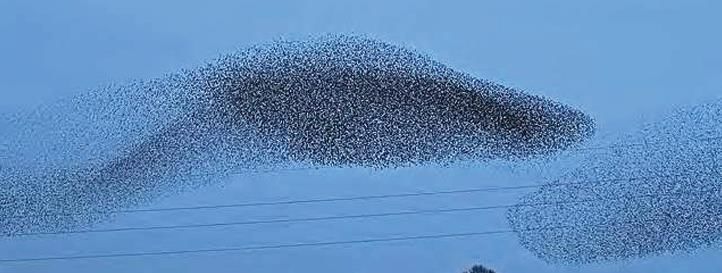
A picture of a starling murmuration over a farm in the UK. Starling murmuration is a mesmerising aerial display of thousands of starlings flying in synchronised, swirling patterns. It is often described as a ‘choreographed dance’.
Comparing Humans and African Elephants
Human population (2025): 8 × 10⁹
African elephant population: 4 × 10⁵
We divide:

So, there are about 20,000 people for every African elephant.
We can use powers of 10 to write the population of various species:
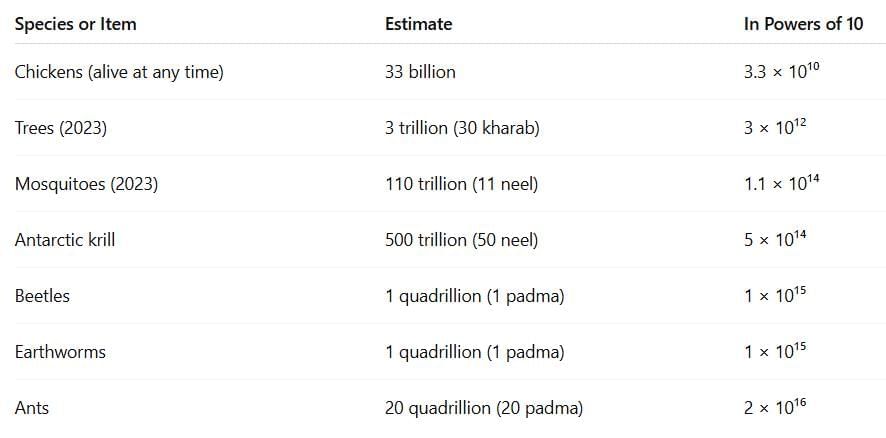
Interesting fact: Ants are so many that their total weight is more than all wild birds and mammals on Earth.
1021 is supposed to be the number of grains of sand on all beaches and deserts on Earth. This is enough sand to give every ant 10 little sand castles to live in.

A sand castle and an Ant
1023 The estimated number of stars in the observable universe is 2 × 1023.
1025 There are an estimated 2 × 1025 drops of water on Earth (assuming 16 drops per millilitre)
A different way to say your age!
“How old are you?” asked Estu.
“I completed 13 years a few weeks ago!” said Roxie.
“How old are you?” asked Estu again.
“I’m 4840 days old today!” said Roxie.
“How old are you?” asked Estu again.
“I’m ______ hours old!” said Roxie.
Make an estimate before finding this number.
Estu: “I am 4070 days old today. Can you find out my date of birth?”
If you have lived for a million seconds, how old would you be?
1,000,000 seconds ≈ 11.6 days
We shall look at approximate times and timelines of some events and phenomena, and use powers of 10 to represent and compare these quantities.
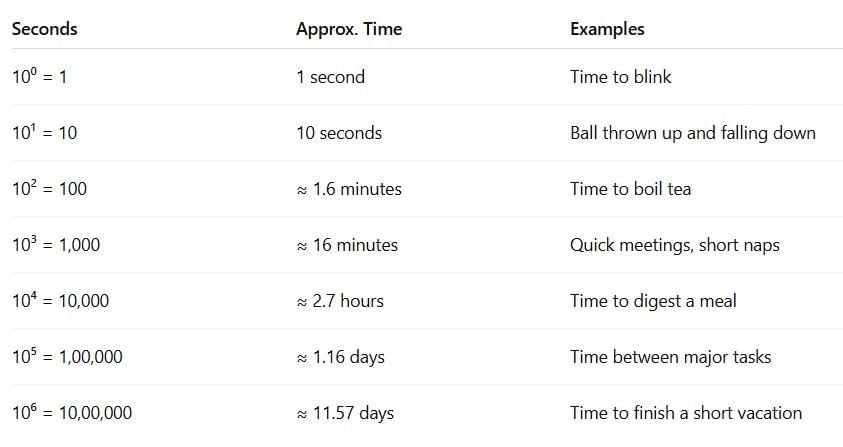
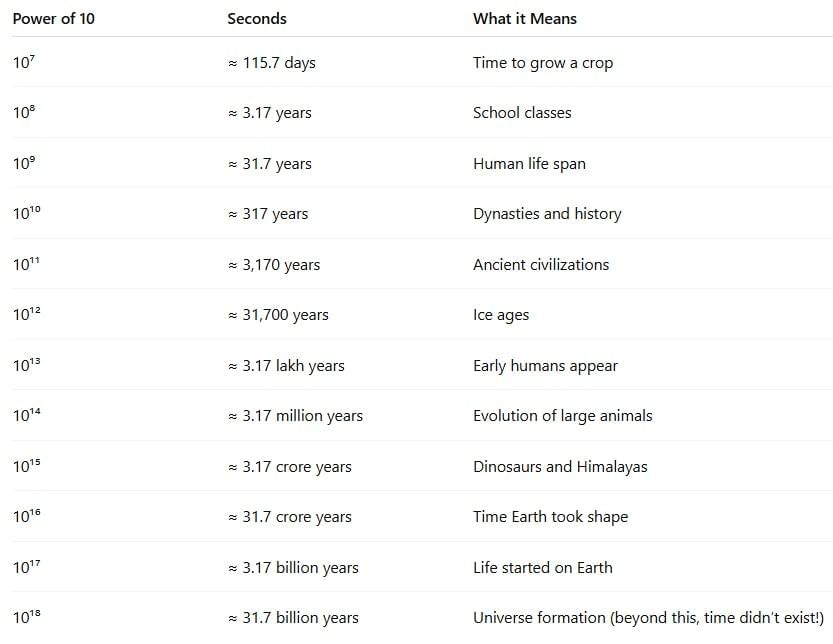
Fun Fact
10⁶ seconds is less than 2 weeks, but 10⁹ seconds is over 31 years!
This shows how fast exponential growth happens.
A Pinch of History
Ancient Indian texts like Lalitavistara, Ganita-Sara-Sangraha, and Amalasiddhi talk about extremely large numbers.
These texts belonged to Buddhist and Jaina traditions and were written over 2000 years ago.
Lalitavistara: Dialogue Between Arjuna and Prince Gautama
This is a Buddhist text from the 1st century BCE.
It gives names for very large numbers by multiplying powers of 10.
Example:
1 hundred kotis = 1 ayuta = 10⁹
1 hundred ayutas = 1 niyuta = 10¹¹
... and it continues up to 10⁵³
Other Ancient Indian Texts
- Mahaviracharya (a Jain mathematician) listed numbers up to 10²³.
A Jain text named Amalasiddhi went up to 10⁹⁶.
A grammar book by Kāccāyana (in Pali language) mentioned numbers up to 10¹⁴⁰ called asaṅkhyeya (meaning uncountable).
How They Named Large Numbers (Power Play)
They used bases like:
Sahassa = 1 thousand
Koti = 1 crore (10 million)
For example:
Prayuta (10⁶) was said as “10 hundred thousand”
This is similar to how we say:
1 lakh = 100 × 1,000 = 1,00,000 (10⁵)
1 crore = 100 × 1 lakh = 1,00,00,000 (10⁷)
1 arab = 100 × 1 crore = 10⁹
And so on…
Fun Facts About Huge Numbers
- Googol = 10¹⁰⁰ (a 1 followed by 100 zeros)
Googolplex = 10^Googol (a 1 followed by a googol of zeros)
Estimated number of atoms in the universe = between 10⁷⁸ and 10⁸²
So, googolplex is much larger than anything in the real world.
Highest Currency Notes in History
In India, the highest note is ₹2000
Hungary (1946): Printed a note of 1 sextillion pengő (10²¹) – but it was never used.
Zimbabwe (2009): Printed a note of 100 trillion dollars (10¹⁴) – it was worth only around 30 US dollars

FAQs on Power Play Chapter Notes - Chapter Notes For Class 8
| 1. What is exponential notation and how is it used in mathematics? |  |
| 2. How do you perform operations with powers of 10? |  |
| 3. What are some common applications of powers of 10 in real life? |  |
| 4. Why is it important to understand the concept of powers and exponents? |  |
| 5. Can you explain the 'other side of powers' mentioned in the article? |  |





















